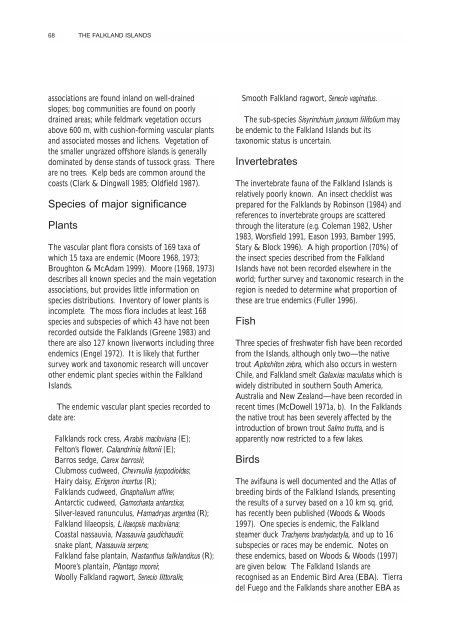Biodiversity: the UK Overseas Territories - WIDECAST
Biodiversity: the UK Overseas Territories - WIDECAST
Biodiversity: the UK Overseas Territories - WIDECAST
You also want an ePaper? Increase the reach of your titles
YUMPU automatically turns print PDFs into web optimized ePapers that Google loves.
68<br />
THE FALKLAND ISLANDS<br />
associations are found inland on well-drained<br />
slopes; bog communities are found on poorly<br />
drained areas; while feldmark vegetation occurs<br />
above 600 m, with cushion-forming vascular plants<br />
and associated mosses and lichens. Vegetation of<br />
<strong>the</strong> smaller ungrazed offshore islands is generally<br />
dominated by dense stands of tussock grass. There<br />
are no trees. Kelp beds are common around <strong>the</strong><br />
coasts (Clark & Dingwall 1985; Oldfield 1987).<br />
Species of major significance<br />
Plants<br />
The vascular plant flora consists of 169 taxa of<br />
which 15 taxa are endemic (Moore 1968, 1973;<br />
Broughton & McAdam 1999). Moore (1968, 1973)<br />
describes all known species and <strong>the</strong> main vegetation<br />
associations, but provides little information on<br />
species distributions. Inventory of lower plants is<br />
incomplete. The moss flora includes at least 168<br />
species and subspecies of which 43 have not been<br />
recorded outside <strong>the</strong> Falklands (Greene 1983) and<br />
<strong>the</strong>re are also 127 known liverworts including three<br />
endemics (Engel 1972). It is likely that fur<strong>the</strong>r<br />
survey work and taxonomic research will uncover<br />
o<strong>the</strong>r endemic plant species within <strong>the</strong> Falkland<br />
Islands.<br />
The endemic vascular plant species recorded to<br />
date are:<br />
Falklands rock cress, Arabis macloviana (E);<br />
Felton’s flower, Calandrinia feltonii (E);<br />
Barros sedge, Carex barrosii;<br />
Clubmoss cudweed, Chevreulia lycopodioides;<br />
Hairy daisy, Erigeron incertus (R);<br />
Falklands cudweed, Gnaphalium affine;<br />
Antarctic cudweed, Gamochaeta antarctica;<br />
Silver-leaved ranunculus, Hamadryas argentea (R);<br />
Falkland lilaeopsis, Lilaeopsis macloviana;<br />
Coastal nassauvia, Nassauvia gaudichaudii;<br />
snake plant, Nassauvia serpens;<br />
Falkland false plantain, Nastanthus falklandicus (R);<br />
Moore’s plantain, Plantago moorei;<br />
Woolly Falkland ragwort, Senecio littoralis;<br />
Smooth Falkland ragwort, Senecio vaginatus.<br />
The sub-species Sisyrinchium junceum filifolium may<br />
be endemic to <strong>the</strong> Falkland Islands but its<br />
taxonomic status is uncertain.<br />
Invertebrates<br />
The invertebrate fauna of <strong>the</strong> Falkland Islands is<br />
relatively poorly known. An insect checklist was<br />
prepared for <strong>the</strong> Falklands by Robinson (1984) and<br />
references to invertebrate groups are scattered<br />
through <strong>the</strong> literature (e.g. Coleman 1982, Usher<br />
1983, Worsfield 1991, Eason 1993, Bamber 1995,<br />
Stary & Block 1996). A high proportion (70%) of<br />
<strong>the</strong> insect species described from <strong>the</strong> Falkland<br />
Islands have not been recorded elsewhere in <strong>the</strong><br />
world; fur<strong>the</strong>r survey and taxonomic research in <strong>the</strong><br />
region is needed to determine what proportion of<br />
<strong>the</strong>se are true endemics (Fuller 1996).<br />
Fish<br />
Three species of freshwater fish have been recorded<br />
from <strong>the</strong> Islands, although only two—<strong>the</strong> native<br />
trout Aplochiton zebra, which also occurs in western<br />
Chile, and Falkland smelt Galaxias maculatus which is<br />
widely distributed in sou<strong>the</strong>rn South America,<br />
Australia and New Zealand—have been recorded in<br />
recent times (McDowell 1971a, b). In <strong>the</strong> Falklands<br />
<strong>the</strong> native trout has been severely affected by <strong>the</strong><br />
introduction of brown trout Salmo trutta, and is<br />
apparently now restricted to a few lakes.<br />
Birds<br />
The avifauna is well documented and <strong>the</strong> Atlas of<br />
breeding birds of <strong>the</strong> Falkland Islands, presenting<br />
<strong>the</strong> results of a survey based on a 10 km sq. grid,<br />
has recently been published (Woods & Woods<br />
1997). One species is endemic, <strong>the</strong> Falkland<br />
steamer duck Trachyeres brachydactyla, and up to 16<br />
subspecies or races may be endemic. Notes on<br />
<strong>the</strong>se endemics, based on Woods & Woods (1997)<br />
are given below. The Falkland Islands are<br />
recognised as an Endemic Bird Area (EBA). Tierra<br />
del Fuego and <strong>the</strong> Falklands share ano<strong>the</strong>r EBA as
















